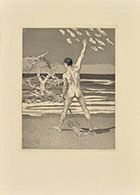Leipzig 1857 - Naumburg 1920
Among the most prolific and creative printmakers of his era, Klinger revived printmaking in his native country. Klinger, who had received some training at the Karlsruhe art school, created a sensation at the Berlin Academy exhibition in 1878 with two series of pen-and-ink drawings. One upon the theme of Christ, the other upon the Finding of a Glove. Their daring originality caused an outburst of indignation; nonetheless, the Glove series, on which Klinger’s contemporary reputation is based, was bought by the Berlin National Gallery. These 10 drawings (engraved in three editions from 1881) tell a strange parable of a hapless young man and his obsessive involvement with a woman’s elbow-length glove. Between 1879 and 1910, Klinger printed thirteen series of themed etching art prints, which he called cycles. Each series was given a name and an opus number which was inspired by his love of music. Klinger used his prints to highlight contemporary social issues. His print series were an inspiration for symbolist artists, including Edvard Munch, Lovis Corinth, Max Slevogt, and for future surrealist artists, such as Max Ernst. In 1883, Klinger moved to Paris where he already had an art following. In 1889, he moved to Rome. In Rome, he was inspired by the Italian Renaissance and antiquity in general. It was around this time that he started creating sculptures, which he soon became known for. In 1893, Klinger returned to Leipzig, Germany and became a member of the Munich Academy. For the rest of his career, he focused on his sculptures.
